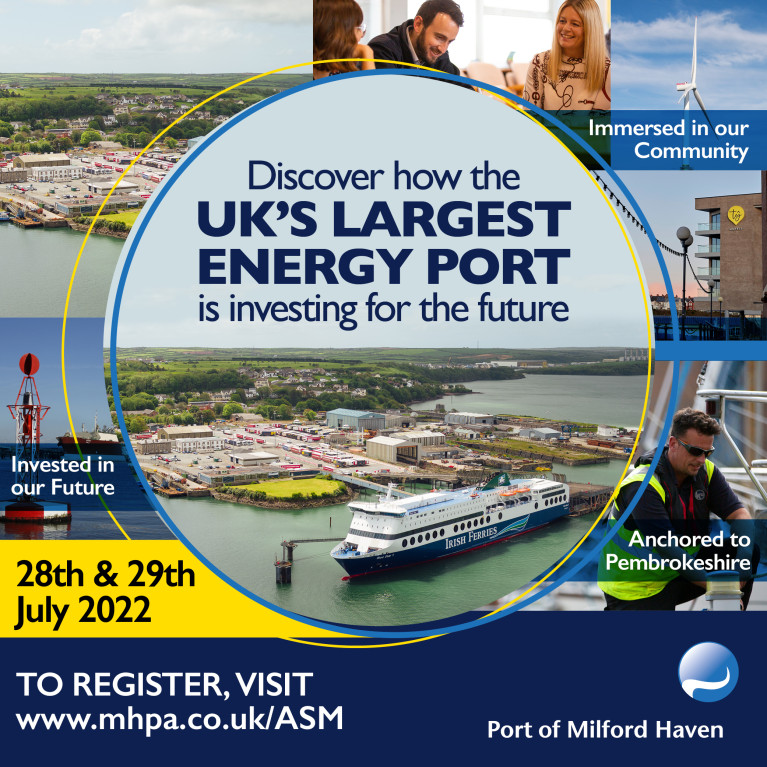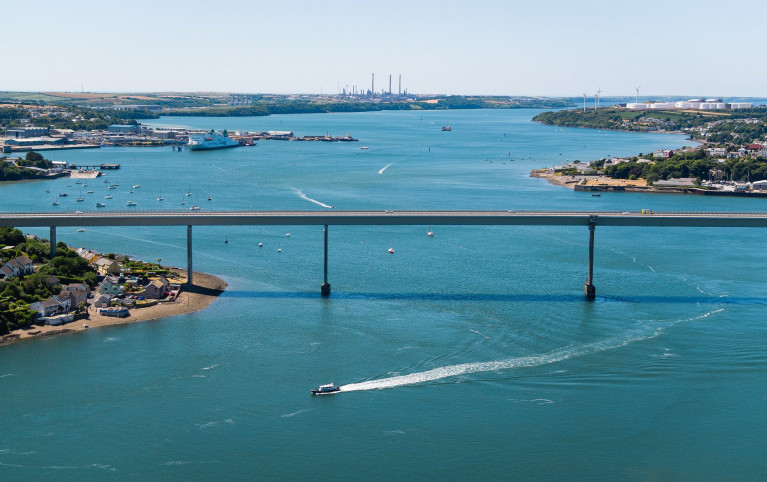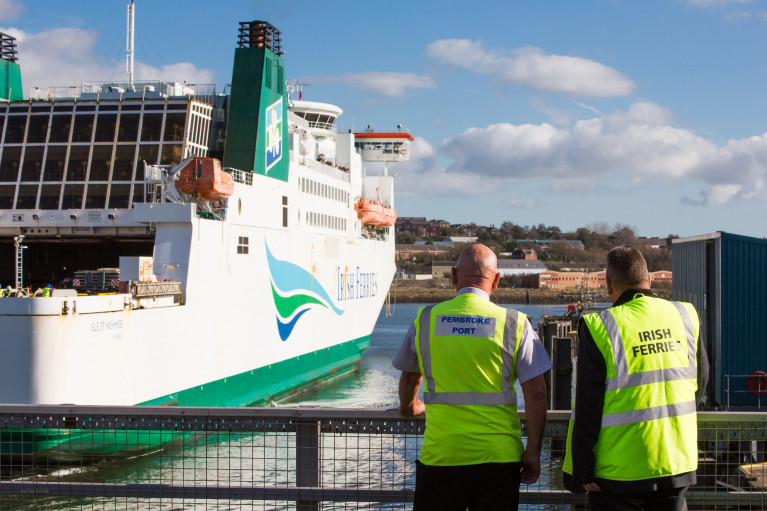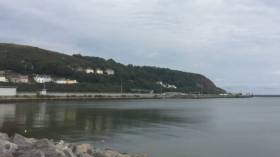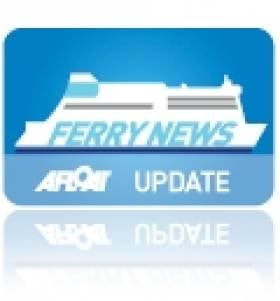Displaying items by tag: Pembroke Dock
In south Wales is where significant progress at Pembroke Dock is being made to create a multi-purpose and future energy-ready port in Pembrokeshire that will create a bright and prosperous outlook for current and future generations.
Physical works on the Swansea Bay City Deal and EU funded Pembroke Dock Marine project began in earnest last August after a breaking ground ceremony marked the start of the construction of a supersize slipway and new workboat pontoons at Pembroke Port.
Since then the landscape of the site has changed dramatically. The slipway is being significantly widened to 68 metres and extended to offer greater flexibility for developers and marine businesses looking to test new marine energy devices, launch and recover vessels, and supply chain companies providing maintenance and engineering services to floating offshore wind device operators in the Celtic Sea. Once complete in Spring 2024, the wider slipway will measure 11,352sqm which is the equivalent of one and half football pitches. Materials from the works to enlarge the slipway are being recycled and used to create much-needed laydown space by infilling the timber pond.
New workboat pontoons are being installed to the east of the existing ferry terminal offering short and long term berthing options for workboats, barges and jack up barges, positioned neatly between Quay 1 and the new slipway. These are already proving popular and will be available to utilise from Autumn 2023.
At Gate 1, the four new annexes attached to the historic Sunderland Hangars are nearing completion. These will offer modern offices and workshops ideally situated for companies in the renewables and marine sectors looking for a new base within a busy commercial port. Brand new office space and workshops allow for a flexible working solution ideal for developers and supply chain businesses. The four hangar annexes are in the final stages of completion and will be ready for occupation this summer. Renamed Oleander House, Catalina House, Falcon House & Erebus House they offer a range of one and two storey office space and workshop areas, with two contracts currently under negotiation.
Commercial Director at the Port of Milford Haven, Steve Edwards, is pleased with the progress being made at Pembroke Port. He said “These works will make a huge difference to the facilities and services that we can offer to the marine sector but also the growing renewables industry that is being attracted here due to the exciting opportunities for floating offshore wind projects in the Celtic Sea. The team at the Port and contractors BAM Nuttall, the Walters Group Walters Group and R&M Williams are keeping the project on track and I am confident we will attract some iconic and innovative companies that want to base themselves at Pembroke Port.”
Councillor Rob Stewart, Chairman of the Swansea Bay City Deal’s Joint Committee, said “The City Deal is making significant progress through the Pembroke Dock Marine project by growing the economy and creating employment opportunities with a particular focus on the energy sector and renewable technologies. The work that R&M Williams and BAM Nuttall are completing in the Hangar Annexes, pontoons and slipway will regenerate Pembroke Port as well as support the blue-green energy economy, which is fundamental for the future of South West Wales. Coupled with the recent success of the Celtic Freeport bid, it strengthens our ambitions to create a prosperous region for businesses to thrive and residents to access well-paid jobs, both now and in the future.”
Pembroke Dock Marine is funded by the UK Government and Welsh Government through the Swansea Bay City Deal, and through the public and private sectors. It is also part funded by the European Regional Development Fund through the Welsh Government.
See the progress being made so far online at: Pembroke Port Developments on Youtube
The Port of Milford Haven in south Wales has made a significant contribution to ensure six pontoons continue to be available for leisure users of the Milford Haven Waterway for another decade.
Working collaboratively with Pembrokeshire County Council, the Port will assist with costs towards the management, maintenance and repair of the facilities at Dale, Burton, Neyland, Hobbs Point in Pembroke Dock, and Hazelbeach, for the next ten years.
The pontoons are used by recreational vessels and for people and equipment to be dropped off and collected. Five are shore-connecting and deployed at their locations between April and October, while the outer pontoon at Dale remains in location all year. Boats can stay for up to 12 hours for their passengers to enjoy their surroundings, whether that be fishing, water sports or going ashore.
Leisure users who are looking forward to making the most of the great outdoors this summer are reminded to plan their activities carefully, for example by checking the tides, letting someone know the details of their journey, ensuring their vessel is seaworthy and knowing how to call for help. More helpful safety tips can be found online.
Harbourmaster at the Port of Milford Haven, Mike Ryan, commented “The Milford Haven Waterway is a fantastic stretch of water for people to spend their leisure time. Many locals and visitors to the area make use of these pontoons for water-based activities, so we’re pleased to contribute to their upkeep to ensure they remain safe for everyone to enjoy.”
Councillor Rhys Sinnett, Cabinet Member for Residents’ Services, said “We are extremely grateful to the Port of Milford Haven for their contribution to ensure these six pontoons continue to be available for residents and visitors. This is an excellent example of local bodies working together in partnership for the local community.”
He continued “The Haven Waterway is one of our greatest assets and we know just how important these pontoons are, not just for those visiting the area but also for our local boat users and residents to enjoy the Waterway.”
The Milford Haven Waterway 5 Year Recreation Management Plan contains details about recreational activities and can be viewed here.
The Pembrokeshire community in south-west Wales have been successful in naming four new buildings at the Port of Pembroke that are being created to service the growing renewables industry in the county.
The annexes attached to the historic Sunderland Hangars at Pembroke Port are being redeveloped into modern office and workshop spaces with work expected to be completed by Spring 2023.
A public competition was held giving people the chance to name the new buildings which attracted a wealth of creative suggestions and were judged by a panel consisting of the Chair of the Port of Milford Haven Chris Martin, Mayor of Pembroke Dock Councillor Joshua Beynon, Rik Saldanha from the Pembroke Dock Heritage Trust, Phil Collins from the West Wales Maritime Heritage Centre and Tim James, now at Celtic Sea Power.
The panel were delighted with the range of submissions and the chosen names Erebus House, Catalina House, Falcon House and Oleander House were suggested by David Lockwood, the Pembroke Dock Heritage Trust, Marie Sampson, Victoria Allen and Tyler Streitberger respectively.
Commercial Director at the Port of Milford Haven, Steve Edwards, commented “These structures date back to the early 1900s so we felt it was important to recognise and celebrate their heritage. Work is progressing well to give new life to the annexes and make them fit for industry. The wider Pembroke Dock Marine project is a huge opportunity to create hundreds of well paid jobs in the community, not only in the renewables sector but for the entire supply chain, so we’re really excited that work is underway on this phase of the development.”
Pembroke Dock Marine is expected to generate £73.5m annually to the regional economy, create opportunities for around 1,800 jobs for today’s workforce and the next generation, and contribute 1,000MW to UK and Welsh decarbonisation targets.
Pembroke Dock Marine is a partnership project between the Port of Milford Haven, Offshore Renewable Energy Catapult, Marine Energy Wales and Celtic Sea Power. It is funded by the UK Government and Welsh Government through the Swansea Bay City Deal, and through the public and private sectors. It is also part funded by the European Regional Development Fund through the Welsh Government.
History of winning names
Erebus House
The HMS Erebus was built in Pembroke Dock, which at the time was the only Royal Dockyard in Wales. Launched in 1826, HMS Erebus went on to take part in John Franklin’s lost expedition under the command of James Clark Ross to the Antarctic in the 1840s, along with HMS Terror. The expedition was one of history’s greatest mysteries with both ships and its crew disappearing until there was a breakthrough in September 2014, when the shipwreck of HMS Erebus was discovered to the east of Queen Maud Gulf, Canada.
Catalina House
During World War II, the most used aircrafts at the time were the American-built PBY Catalina, which were originally introduced in the 1930s. The flying boat did not need a runway and played a significant role during the Battle of the Atlantic, with the Catalinas operating out of Pembroke Dock by the Royal Air Force, as well as the United States Navy.
Falcon House
The first of two HMS Falcons to be built at Pembroke Dock during the 1810s, launching in June 1820, was a Cherokee Class warship for the Royal Navy. The second HMS Falcon to be built in the Pembroke Dockyard was a Wooden Screw Sloop vessel, and was launched in August 1854 to serve during the Crimean War in the Baltic Sea, also participating in the siege off the coast of Courlan.
Fast forward to 1979, and a highly classified project, which still remains Pembroke Dock’s ‘worst kept secret’, saw the construction of a famous (Star Wars: 'Empire Strikes Back') spaceship story in the Western Hangar.
Oleander House
The last ship to be built at the Royal Naval Dockyard in Pembroke Dock was the RFA tanker Oleander, which was only one of six ships in its class.
Construction on the Oleander first started in December 1920 and it was launched in April 1922. RFA Oleander met its fate in May 1940 when the ship was severely damaged by a near miss during an air attack in Norway.
Port of Milford Haven, Wales to Hold Annual Stakeholder Meetings to Engage with Local Community
In south Wales, the Port of Milford Haven is to host two Annual Stakeholder Meetings this year so to update members of the community on its latest developments and listen to feedback from the public.
Tom Sawyer, the Port’s new Chief Executive who joined in April, along with Chair, Chris Martin, will provide an overview on the organisation’s performance and vision, as well as updates on projects such as Pembroke Dock Marine, Milford Waterfront and its core business - servicing shipping on the Waterway.
Tom commented “I’m looking forward to meeting our stakeholders, many of whom I won’t have come across yet, in Pembroke Dock and Milford Haven. The sessions are a chance for the public to hear about what has been happening at the Port over the past year as we start to recover from the effects of Covid, but also about how our plans for future growth are progressing.”
He continued “One area I’d welcome feedback on is how we can do more to help our local community in a time when the cost of living is increasing and having a huge impact on peoples’ daily lives. We want to help where we can and understanding the extent of the problem is the first step towards addressing this.”
The events take place on:
Thursday 28th July at the Pater Hall, Pembroke Dock, 4.30-6.30pm
Friday 29th July at the Pill Social Centre, Milford Haven, 3-5pm
To register please email: [email protected] or call 01646 696100 and specify which date you would prefer, along with any questions you would like to ask the team.
There will also be an opportunity to join the meetings online (visit: www.mhpa.co.uk/ASM for more details).
Naming Competition Launched in Wales for Pembroke Dock's Historic Buildings
In south Wales the port of Pembroke Dock has a rich maritime history having been a military town for 150 years. Today, the former Royal Naval Dockyard is a commercial port including a ferry link to Ireland in addition to having an exciting future in the renewables industry.
The Port of Milford Haven forms a key part of the £60m Swansea Bay City Deal’s Pembroke Dock Marine project which will deliver the facilities, services and spaces needed to establish a world-class centre for marine energy and engineering.
As part of this, four Grade II listed annexes attached to the Sunderland Hangars are in need of renovation to bring them into the 21st century and offered as flexible modern workspaces. The building works will begin in November 2021 and are on schedule to be completed by November 2022.
Today, the Port is launching a naming competition for the four annexes and is inviting submissions from members of the community. There are four suggested themes: heritage, renewable future, maritime and social history, but all ideas are welcome.
Commercial Director at the Port, Steve Edwards, said “Pembroke Port is steeped in history and we want to ensure we preserve these buildings so they can be used in the next exciting chapter. Pembroke Dock Marine offers huge opportunities for the town as well as the entire region, so it’s really important that we create desirable accommodation for businesses to establish themselves here. We want to involve the whole community in our plans by inviting memorable names with a back story to complement the developments.”
To submit your suggestions, visit the port's website here by Monday 18th October.
Pembroke Dock Marine is funded by the Swansea Bay City Deal, the European Regional Development Fund through the Welsh Government, and through private investment.
Ferryport of Pembroke Dock is where fears that the south Wales port could become a casualty of Brexit have proved unfounded, with Irish Ferries signing a 10-year deal with the Port of Milford Haven.
The company has signed the deal with the Port of Milford Haven for the berth at Pembroke Dock, which first came into operation under B&I Line in 1979. (Afloat adds see reference to MV Connacht's maiden sailing of Cork-Swansea before switching the Welsh port to Pembroke)
Since then, the port of Pembroke has seen multimillion pound investments to improve facilities and creating jobs and has become established as an important transport link with Europe.
In recent weeks, Westminster politicians have raised the suggestion that, as a result of Brexit, Pembrokeshire could only support a single port linking the county and the M4 corridor with the Irish Republic.
Member of the Senedd for Mid and West Wales Eluned Morgan has welcomed the decision, saying it underlines its commitment to the port of Pembroke.
More writes Western Telegraph on this development.
As Afloat reported earlier this month, general manager of Rosslare Europort said Wales should focus on just one ferry port in Pembrokeshire instead of two (Fishguard Harbour) to run alongside the main ferry port of Holyhead. The GM citing this would entice hauliers back to Welsh routes crossing the Irish Sea.
South Wales Ferryport of Fishguard 'Losing Out' to Pembroke Dock
#FerryNews - In south Wales, the former leader of Pembrokeshire County Council has said Fishguard is losing out to Pembroke Dock because the A40 road to the port is so bad.
As BBC News reports, Councillor John Davies wants the Welsh Government to fund the widening of the A40 all the way to Fishguard.
The Stena ferry company has dropped a £5m upgrade for Fishguard, described as a "worrying" move by local politicians.
But Welsh Government minister Baroness Eluned Morgan said there was less money for roads because of austerity.
For more on this story, click the link.
Irish Ferries Signs 10-Year Contract On Welsh Route
The St. Georges channel crossing carries over 300,000 passengers and 80,000 freight annually and is served by the 34,031grt Isle of Inishmore. The ro-pax can handle 2,200 passengers, 802 cars / 152 freight trailers and is scheduled to two daily round trips, on a route that take nearly five hours.
The 1997 Dutch built vessel was first launched onto the central corridor route between Dublin-Holyhead but was transferred to the southern service after the introduction of Ulysses in 2001.
Rosslare-Pembroke Dock sailings only began in 1980, firstly operated by the B+I Line which competed with rival operators Sealink / British Rail (now Stena Line) on services running out of Fishguard.
This route was well established having started operations in 1906 and in an era when the railway companies (in this case the Great Western Railway) developed and owned the ports plus the operation of shipping services on the Irish Sea.
Ferry-Go-Round on the Irish Sea
In the case of Irish Ferries, their Rosslare-Pembroke Dock route vessel, Isle of Inishmore arrived on the Mersey yesterday at the Cammell Laird dry-dock facility in Birkenhead.
The 1997 Dutch-built Isle of Inishmore had relieved the 50,938 tonnes 'flagship' Ulysses from the Dublin-Holyhead route which too had gone to Birkenhead for maintenance since January 4th.
The Ulysses is now back on service and the company's French routes cruiseferry, Oscar Wilde is covering the Isle of Inishmore's absence from Rosslare-Pembroke Dock sailings.
Continental services to France on the Rosslare-Cherbourg route will resume on February 16th when the Oscar Wilde returns from her overall. The Bahamas flagged vessel will re-open seasonal Rosslare-Roscoff sailings starting on May 13th.
In addition to conventional tonnage Irish Ferries also operate the fast-craft catamaran Jonathan Swift in tandem with Ulysses on the Dublin-Holyhead route. The Ulysses takes 3 hours 25 minutes while the 39-knot catamaran craft marketed as the Dublin 'Swift' is advertised with a scheduled passage time of 1 hour and 49 minutes.
The Australian-built catamaran was taken off the central corridor route yesterday to be drydocked also in Birkenhead until January 18th. Dublin Swift sailings return to the Dublin-Holyhead route on February 19th with the first crossing to depart at 14.30 hours from the capital port.
For the latest information on ferry sailings and reservations click: www.irishferries.com


























